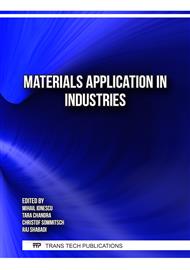[1]
Puleo, D.A. and Huh, W.W., 1995. Acute toxicity of metal ions in cultures of osteogenic cells derived from bone marrow stromal cells. Journal of Applied Biomaterials, 6(2), pp.109-116.
DOI: 10.1002/jab.770060205
Google Scholar
[2]
Staiger, M.P., Pietak, A.M., Huadmai, J. and Dias, G., 2006. Magnesium and its alloys as orthopedic biomaterials: a review. Biomaterials, 27(9), pp.1728-1734.
DOI: 10.1016/j.biomaterials.2005.10.003
Google Scholar
[3]
Axinte, E., 2012. Metallic glasses from "alchemy" to pure science: Present and future of design, processing and applications of glassy metals. Materials & Design, 35, pp.518-556.
DOI: 10.1016/j.matdes.2011.09.028
Google Scholar
[4]
Wang, X., Gong, P. and Yao, K.F., 2016. Mechanical behavior of bulk metallic glass prepared by copper mold casting with reversed pressure. Journal of Materials Processing Technology, 237, pp.270-276.
DOI: 10.1016/j.jmatprotec.2016.06.023
Google Scholar
[5]
Gu, X., Zheng, Y., Zhong, S., Xi, T., Wang, J. and Wang, W., 2010. Corrosion of, and cellular responses to Mg–Zn–Ca bulk metallic glasses. Biomaterials, 31(6), pp.1093-1103.
DOI: 10.1016/j.biomaterials.2009.11.015
Google Scholar
[6]
Wang, Y.B., Xie, X.H., Li, H.F., Wang, X.L., Zhao, M.Z., Zhang, E.W., Bai, Y.J., Zheng, Y.F. and Qin, L., 2011. Biodegradable CaMgZn bulk metallic glass for potential skeletal application. Acta biomaterialia, 7(8), pp.3196-3208.
DOI: 10.1016/j.actbio.2011.04.027
Google Scholar
[7]
Wang, G., Liaw, P.K., Senkov, O.N., Miracle, D.B. and Morrison, M.L., 2009. Mechanical and Fatigue Behavior of Ca65Mg15Zn20 Bulk‐Metallic Glass. Advanced Engineering Materials, 11(1‐2), pp.27-34.
DOI: 10.1002/adem.200800313
Google Scholar
[8]
Morrison, M.L., Buchanan, R.A., Liaw, P.K., Senkov, O.N. and Miracle, D.B., 2006. Electrochemical behavior of Ca-based bulk metallic glasses. Metallurgical and Materials Transactions A, 37(4), pp.1239-1245.
DOI: 10.1007/s11661-006-1075-x
Google Scholar
[9]
Zberg, B., Uggowitzer, P.J. and Löffler, J.F., 2009. MgZnCa glasses without clinically observable hydrogen evolution for biodegradable implants. Nature materials, 8(11), pp.887-891.
DOI: 10.1038/nmat2542
Google Scholar
[10]
Li, H., Pang, S., Liu, Y., Sun, L., Liaw, P.K. and Zhang, T., 2015. Biodegradable Mg–Zn–Ca–Sr bulk metallic glasses with enhanced corrosion performance for biomedical applications. Materials & Design, 67, pp.9-19.
DOI: 10.1016/j.matdes.2014.10.085
Google Scholar
[11]
Mudali, U.K., Scudino, S., Kühn, U., Eckert, J. and Gebert, A., 2004. Polarisation behaviour of the Zr57Ti8Nb2. 5Cu13. 9Ni11. 1Al7. 5 alloy in different microstructural states in acid solutions. Scripta materialia, 50(11), pp.1379-1384.
DOI: 10.1016/j.scriptamat.2004.02.039
Google Scholar
[12]
Inoue, A., 2000. Stabilization of metallic supercooled liquid and bulk amorphous alloys. Acta materialia, 48(1), pp.279-306.
DOI: 10.1016/s1359-6454(99)00300-6
Google Scholar
[13]
Senkov, O.N. and Scott, J.M., 2005. Glass forming ability and thermal stability of ternary Ca–Mg–Zn bulk metallic glasses. Journal of non-crystalline solids, 351(37-39), pp.3087-3094.
DOI: 10.1016/j.jnoncrysol.2005.07.022
Google Scholar
[14]
Hu, L. and Ye, F., 2013. Crystallization kinetics of Ca65Mg15Zn20 bulk metallic glass. Journal of alloys and compounds, 557, pp.160-165.
DOI: 10.1016/j.jallcom.2012.12.158
Google Scholar
[15]
Chen, L.C. and Spaepen, F., 1988. Calorimetric evidence for the micro-quasicrystalline structure of'amorphous' Al/transition metal alloys. Nature, 336(6197), pp.366-368.
DOI: 10.1038/336366a0
Google Scholar
[16]
McCafferty, E., 2005. Validation of corrosion rates measured by the Tafel extrapolation method. Corrosion science, 47(12), pp.3202-3215.
DOI: 10.1016/j.corsci.2005.05.046
Google Scholar
[17]
Jiang, L., Chen, Z.Q., Lu, H.B., Ke, H.B., Yuan, Y., Dong, Y.M. and Meng, X.K., 2021. Corrosion protection of NiNb metallic glass coatings for 316SS by magnetron sputtering. Journal of Materials Science & Technology, 79, pp.88-98.
DOI: 10.1016/j.jmst.2020.12.004
Google Scholar
[18]
Wang, Y., Tan, M.J., Pang, J., Wang, Z. and Jarfors, A.W., 2012. In vitro corrosion behaviors of Mg67Zn28Ca5 alloy: from amorphous to crystalline. Materials Chemistry and Physics, 134(2-3), pp.1079-1087.
DOI: 10.1016/j.matchemphys.2012.03.116
Google Scholar



